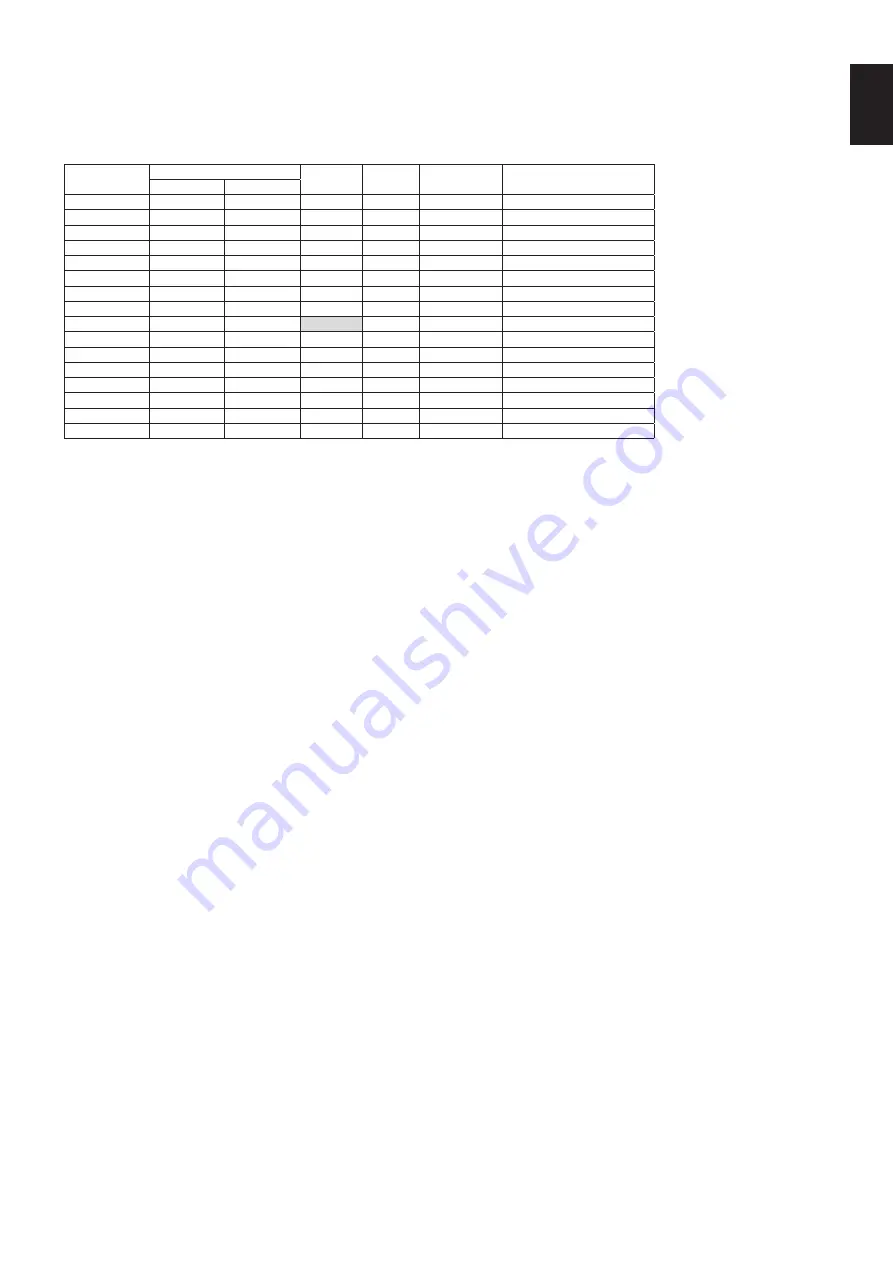
English-15
English
Connecting a Personal Computer
Connecting your computer to your LCD monitor will enable you to reproduce your computer’s video signal output.
Some display cards may not be able to support the required resolution for proper image reproduction.
Your LCD monitor shows proper image by adjusting the factory preset timing signal automatically.
<Typical factory preset signal timing>
Resolution
Scanning frequency
VGA
HDMI
DisplayPort
1.1a
Remarks
Horizontal
Vertical
640 x 480
31.5 kHz
60 Hz
Yes
Yes
Yes
800 x 600
37.9 kHz
60 Hz
Yes
Yes
Yes
1024 x 768
48.4 kHz
60 Hz
Yes
Yes
Yes
1280 x 720
45.0 kHz
60 Hz
Yes
Yes
Yes
1280 x 768
47.8 kHz
60 Hz
Yes
Yes
Yes
1280 x 800
49.7 kHz
60 Hz
Yes
Yes
Yes
1280 x 960
60.0 kHz
60 Hz
Yes
Yes
Yes
1280 x 1024
64 kHz
60 Hz
Yes
Yes
Yes
1360 x 768
47.7 kHz
60 Hz
No
Yes
Yes
1366 x 768
47.7 kHz
60 Hz
Yes
Yes
Yes
1400 x 1050
65.3 kHz
60 Hz
Yes
Yes
Yes
1440 x 900
55.9 kHz
60 Hz
Yes
Yes
Yes
1600 x 1200
75.0 kHz
60 Hz
Yes
Yes
Yes
Compressed image
1680 x 1050
65.3 kHz
60 Hz
Yes
Yes
Yes
1920 x 1080
67.5 kHz
60 Hz
Yes
Yes
Yes
Recommended resolution
1920 x 1200
74.6 kHz
60 Hz
Yes
Yes
Yes
Compressed image
Connecting a Player or Computer with HDMI
• Please use an HDMI cable with the HDMI logo.
• It may take a moment for the signal to appear.
• Some display cards or drivers may not display an image correctly.
• When you use a computer with HDMI, please set OVER SCAN to “AUTO” or “OFF” (see page 28).
• Please check display card when image is compressed with 1920 x
1080.
•
To output HDMI audio, set [HDMI1], [HDMI2] or [HDMI3] at AUDIO INPUT in the OSD or choose [HDMI1], [HDMI2] or
[HDMI3] by the remote control AUDIO INPUT button.
•
If the monitor’s main power is turned on after a connected computer is turned on, sometimes images are not displayed.
In this case, please turn off the computer then turn it on again.
Connecting a Computer with DisplayPort
• Please use a DisplayPort cable with the DisplayPort compliance logo.
• It may take a moment for the signal to appear.
• When connecting a DisplayPort cable to a component with a signal conversion adapter, an image may not appear.
• Select DisplayPort cables feature a locking function. When removing this cable, hold down the top button to release the lock.
•
To output DisplayPort audio, set [DisplayPort] at AUDIO INPUT in the OSD or choose [DisplayPort] by the remote control
AUDIO INPUT button.
•
If the monitor’s main power is turned on after a connected computer is turned on, sometimes images are not displayed.
In this case, please turn off the computer then turn it on again.
Connecting a USB device
USB (2A): USB downstream port (Type-A).
To use the Media Player function, please use this port.
• Please make sure the connector shape and orientation
is correctly aligned when connecting the USB device or cable.
•
Please refer to the specifications page for power supply information (see page 53, page 54 and page 55).
•
When you use the USB (2A) port for power supply, please use a USB cable that supports 2A.
•
Do not bind the USB cable. It may cause heat or fire.






























